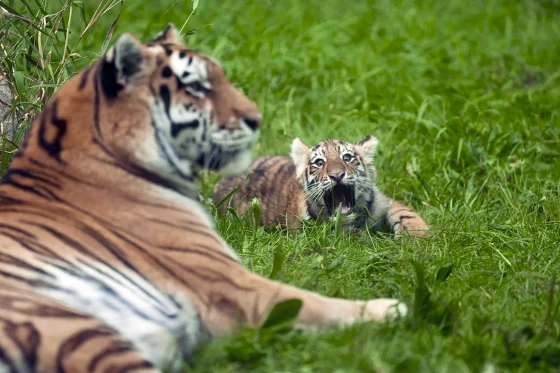Scientists estimate that the Amur tiger population is just 00 to 500 in the wild and that the species was near the brink of extinction in the 1930s and 1940s.
APPLE VALLEY, Minn. — Two rare Amur tiger cubs are making their highly anticipated public debut at the Minnesota Zoo, sparking hope for the preservation of this endangered species, native to far eastern Russia and northern China.
The cubs, named Andrei and Amaliya, experienced the outdoors for the first time on Wednesday, feeling the grass beneath their paws in their new habitat. They were born on May 23 to their 12-year-old mother, Dari, and have been carefully monitored ever since.
“They’ve done incredibly well since birth,” said zoologist Trista Fischer. “We’ve been keeping a close watch on them. Dari has been an exemplary mother, providing exceptional maternal care. Now, they’re fully vaccinated and weigh around 40 to 45 pounds each, which is a significant milestone for them.”
With the global population of Amur tigers estimated at just 400 to 500 individuals, their status remains critical. While their numbers have rebounded slightly since the 1930s and 1940s, they remain vulnerable due to poaching and the difficulty of breeding them in both captivity and the wild. Roughly one in four Amur cubs do not survive to adulthood, highlighting the importance of breeding programs.
The Minnesota Zoo, located in the Minneapolis suburb of Apple Valley, has played a key role in tiger conservation. The zoo’s Amur tigers have produced 57 cubs over the years, with 46 surviving for at least 30 days. Of these, 21 have gone on to have their own litters, contributing another 86 cubs to the global population. The births of Andrei and Amaliya bring the zoo’s current population of Amur tigers to seven, including their father, Luka.
Fischer, who coordinates the Tiger Species Survival Plan (SSP), leads efforts to preserve these big cats through a global breeding program that includes facilities in other countries. The program oversees three tiger subspecies: Sumatran, Malayan, and Amur.
“This litter is incredibly valuable to the population right now,” Fischer said, emphasizing that the genetic diversity of healthy tigers in captivity could one day play a crucial role in bolstering wild populations.
According to zoo spokesperson Zach Nugent, the cubs will remain with their mother for about 18 months before Andrei, the male, is relocated to his own space. This mirrors what happens in the wild, where male cubs begin venturing out independently at a similar age. Amaliya, the female, may stay with Dari a bit longer—up to 24 months—before Fischer determines if either cub should be bred, potentially requiring relocation to another accredited zoo once they are around two years old.
As she watched the cubs explore their enclosure for the first time, Fischer couldn’t help but feel a sense of pride and emotion. “Aww, I love when they get their little Yoda ears,” she said, affectionately comparing the cubs’ pointy ears to those of the Star Wars character. “It’s such a proud moment for our team to see all our hard work come to fruition.”
Though there’s more work ahead, Fischer said the cubs are adjusting beautifully to their new environment. “They’re showing a lot of resilience, which is exactly what we strive for in human care,” she said. “We want them to be confident, adaptable animals, and today they’re demonstrating that beautifully as they explore this new space with their mother.”
